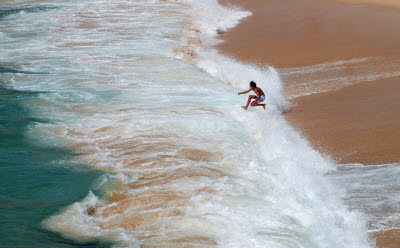Fecal Contamination Affects Sand More than Water
In addition to sunblock, swimsuits and towels, hitting the beach could require hand sanitizer.
 In addition to sunblock, swimsuits and towels, hitting the beach could require hand sanitizer.Photo credit: Alvesgaspar, Wikimedia Commons“No swimming” signs have already popped up this summer along coastlines where fecal bacteria have invaded otherwise inviting waters. Some vacationers ignore the signs while others resign themselves to tanning and playing on the beach. But should those avoiding the water be wary of the sand, too? New research in the American Chemical Society journal Environmental Science & Technology investigates reasons why the answer could be “yes.”
In addition to sunblock, swimsuits and towels, hitting the beach could require hand sanitizer.Photo credit: Alvesgaspar, Wikimedia Commons“No swimming” signs have already popped up this summer along coastlines where fecal bacteria have invaded otherwise inviting waters. Some vacationers ignore the signs while others resign themselves to tanning and playing on the beach. But should those avoiding the water be wary of the sand, too? New research in the American Chemical Society journal Environmental Science & Technology investigates reasons why the answer could be “yes.”
Sewage-contaminated coastal waters can lead to stomach aches, diarrhea and rashes for those who accidentally swallow harmful microbes or come into contact with them. But over the past decade, scientists have been finding fecal bacteria in beach sand at levels 10 to 100 times higher than in nearby seawater. Tao Yan and colleagues wanted to find out why.
In the lab, the researchers created microcosms of beach sand and seawater contaminated with sewage to see how the overall bacterial populations, including fecal dwellers responsible for causing illness, would change over time. They found that microbial communities tended to decay much slower in the simulated beach sand environment than in the water, which could help explain why more fecal bacteria are found on sandy beaches affected by wastewater pollution than in the waves.
The authors acknowledge funding from the Hawaii Department of Health.
